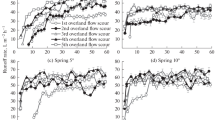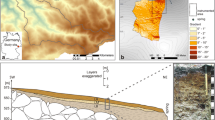Abstract
Subsurface flow is a prominent runoff process in sloping lands of purple soil in the upper Yangtze River basin. However, it remains difficult to identify and quantify. In this study, in situ runoff experimental plots were used to measure soil moisture dynamics using an array of time domain reflectometry (TDR) together with overland flow and subsurface flow using isolated collecting troughs. Frequency of preferential flow during rainfall events and the controls of subsurface flow processes were investigated through combined analysis of soil properties, topography, rainfall intensity, initial wetness, and tillage. Results showed that subsurface flow was ubiquitous in purple soil profiles due to well-developed macropores, especially in surface soils while frequency of preferential flow occurrence was very low (only 2 cases in plot C) during all 22 rainfall events. Dry antecedent moisture conditions promoted the occurrence of preferential flow. However, consecutive real-time monitoring of soil moisture at different depths and various slope positions implied the possible occurrence of multiple subsurface lateral flows during intensive storms. Rainfall intensity, tillage operation, and soil properties were recognized as main controls of subsurface flow in the study area, which allows the optimization of management practices for alleviating adverse environmental effects of subsurface flow in the region.
Similar content being viewed by others
References
Ahuja LR, Elswaify SA, Rahman A (1976) Measuring hydrologic properties of soil with a double-ring infiltrometer and multiple-depth tensiometers. Soil Science Society of America Journal 40: 494–499.
Allaire SE, Roulier S, Cessna AJ (2009) Quantifying preferential flow in soils: A review of different techniques. Journal of Hydrology 378: 179–204.
Anderson AE, Weiler M, Alila Y, Hudson RO (2009) Dye staining and excavation of a lateral preferential flow network. Hydrology and Earth System Sciences 13: 935–944.
Bauters TWJ, DiCarlo DA, Steenhuis TS, Parlange JY (1998) Preferential flow in water-repellent sands. Soil Science Society of America Journal 62: 1185–1190.
Clothier BE, Green SR, Deurer M (2008) Preferential flow and transport in soil: progress and prognosis. European Journal of Soil Science 59: 2–13.
Dunne T, Black RD (1970) Partial area contributions to storm runoff in a small New-England watershed. Water Resources Research 6: 1296–1311.
Famiglietti JS, Rudnicki JW, Rodell M (1998) Variability in surface moisture content along a hillslope transect: Rattlesnake Hill, Texas. Journal of Hydrology 210: 259–281.
Fedoroff N (1997) Clay illuviation in Red Mediterranean soils. Catena 28: 171–189.
Fu T, Ni JP, Wei, CF, Xie DT (2003) Research on the nutrient loss from purple soil under different rainfall intensities and slopes. Plant Nutrtion and Fertilizer Science 9: 71–74. (In Chinese)
Garre S, Koestel J, Gunther T, Javaux M, Vanderborght J, Vereecken H (2010) Comparison of heterogeneous transport processes observed with electrical resistivity tomography in two soils. Vadose Zone Journal 9: 336–349.
Gong ZT (1999) Chinese soil taxonomy. Science Press, Beijing. (In Chinese)
Graham CB, Woods RA, McDonnell JJ (2010) Hillslope threshold response to rainfall: (1) A field based forensic approach. Journal of Hydrology 393: 65–76.
Huang L, Ding SW, Dong Z, Zhang GY (1998) Study on nutrient losses of purple soil in Three Gorges Reservoir region. Chinese Journal of Soil Water Conservation 4: 8–13. (In Chinese)
Jarvis NJ (2007) A review of non-equilibrium water flow and solute transport in soil macropores: principles, controlling factors and consequences for water quality. European Journal of Soil Science 58: 523–546.
Kim HJ, Sidle RC, Moore RD (2005) Shallow lateral flow from a forested hillslope: Influence of antecedent wetness. Catena 60: 293–306.
Klute A (Ed.) (1986) Methods of soil analysis. Part 1. Agron. Monogr. 9. ASA and SSSA, Madison, WI.
Leij FJ, Russell WB, Lesch SM (1997) Closed-form expressions for water retention and conductivity data. Ground Water 35: 848–858.
Li ZM, Zhang XW, He YR, Tang SJ (1991) Purple soil in China (A). Science Press, Beijing.
Lin H (2006) Temporal stability of soil moisture spatial pattern and subsurface preferential flow pathways in the shale hills catchment. Vadose Zone Journal 5: 317–340.
Lin H, Zhou X (2008) Evidence of subsurface preferential flow using soil hydrologic monitoring in the Shale Hills catchment. European Journal of Soil Science 59: 34–49.
Mosley MP (1982) Subsurface flow velocities through selected forest soils, South Island, New Zealand. Journal of Hydrology 55: 65–92.
Oberdorster C, Vanderborght J, Kemna A, Vereecken H (2010) Investigating preferential flow processes in a forest soil using time domain reflectometry and electrical resistivity tomography. Vadose Zone Journal 9: 350–361.
Orlandini S, Mancini M, Paniconi C, Rosso R (1996) Local contributions to infiltration excess runoff for a conceptual catchment scale model. Water Resources Research 32: 2003–2012.
Ovalles FA, Collins ME (1986) Soil-landscape relationships and soil variability in North Central Florida. Soil Science Society of America Journal 50: 401–408.
Pachepsky YA, Timlin DJ, Rawls WJ (2001) Soil water retention as related to topographic variables. Soil Science Society of America Journal 65: 1787–1795.
Qiu Y, Fu BJ, Wang J, Chen LD (2001) Soil moisture variation in relation to topography and land use in a hillslope catchment of the Loess Plateau, China. Journal of Hydrology 240: 243–263.
Rasmussen TC, Baldwin RH, Dowd JF, Williams AG (2000) Tracer vs. pressure wave velocities through unsaturated saprolite. Soil Science Society of America Journal 64: 75–85.
Reynolds WD, Bowman BT, Brunke RR, Drury CF, Tan CS (2000) Comparison of tension infiltrometer, pressure infiltrometer, and soil core estimates of saturated hydraulic conductivity. Soil Science Society of America Journal 64: 478–484.
Tang JL, Zhang B, Gao C, Zepp H (2008) Hydrological pathway and source area of nutrient losses identified by a multi-scale monitoring in an agricultural catchment. Catena 72: 374–385.
Taumer K, Stoffregen H, Wessolek G (2005) Determination of repellency distribution using soil organic matter and water content. Geoderma 125: 107–115.
Taumer K, Stoffregen H, Wessolek G (2006) Seasonal dynamics of preferential flow in a water repellent soil. Vadose Zone Journal 5: 405–411.
Torres R, Alexander LJ (2002) Intensity-duration effects on drainage: Column experiments at near-zero pressure head. Water Resources Research 38, 1240, doi: 1210.1029/2001WR001048.
Weiler M, Flühler H (2004) Inferring flow types from dye patterns in macroporous soils. Geoderma 120: 137–153.
Xiong Y, Li QK (1986) Soils in China. Science Press, Beijing. (In Chinese)
Zhu B, Wang T, You X, Gao MR (2008) Nutrient release from weathering of purplish rock. Pedosphere 18: 257–264.
Zhu B, Wang T, Kuang FH, Luo ZX, Tang JL, Xu TP (2009) Measurements of Nitrate Leaching from a Hillslope Cropland in the Central Sichuan Basin, China. Soil Science Society of America Journal 73: 1419–1426.
Zhu Q, Lin H (2011) Influences of soil, terrain and crop growth on soil moisture variation from transect to farm level scale. Geoderma 163: 45–54.
Author information
Authors and Affiliations
Corresponding author
Rights and permissions
About this article
Cite this article
Tang, J., Zhu, B., Wang, T. et al. Subsurface flow processes in sloping cropland of purple soil. J. Mt. Sci. 9, 1–9 (2012). https://doi.org/10.1007/s11629-012-2199-7
Received:
Accepted:
Published:
Issue Date:
DOI: https://doi.org/10.1007/s11629-012-2199-7




